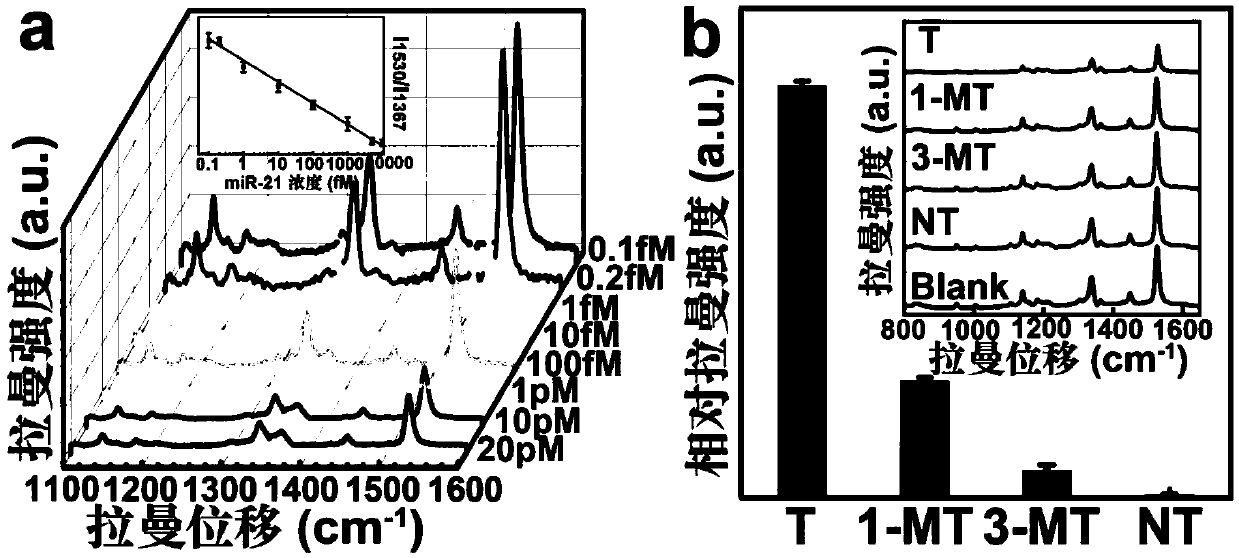Copper phthalocyanine molecule-based diagnosis and treatment integrated nanoprobe as well as preparation and application thereof
A nano-probe, copper phthalocyanine technology, applied in the field of biomedicine, can solve the problems of poor solubility, low molecular selectivity, detection and treatment method limitations, etc., and achieve the effect of small particle size
- Summary
- Abstract
- Description
- Claims
- Application Information
AI Technical Summary
Problems solved by technology
Method used
Image
Examples
Embodiment 1
[0083] Example 1 Preparation of integrated probe for diagnosis and treatment based on copper phthalocyanine molecule
[0084] (1) Disperse 1 g of original hexagonal boron nitride powder in a certain amount of concentrated sulfuric acid under magnetic stirring. 0.5g potassium permanganate (KMnO 4 ) was slowly added into the mixing system, and continued stirring for 12 hours. Then add 10mL of analytically pure hydrogen peroxide (H 2 o 2 ). The resulting suspension was sonicated for 1 hour and then centrifuged at 10000 rpm for 10 minutes to remove large h-BN powder. The supernatant was washed with ultrapure water until the pH of the filtrate was neutral. Finally, the product was placed in a vacuum oven and dried at 60 °C for 24 hours to obtain hexagonal boron nitride nanosheets (h-BNNS).
[0085] The particle size range of the hexagonal boron nitride nanosheets (h-BNNS) is 80-100 nm, and the thickness is about 15 nm. figure 1 A is the transmission electron microscope figur...
Embodiment 2
[0089] The nanoprobe prepared in Example 1 is used for the diagnosis and treatment of tumors, the specific method is as follows:
[0090] (1) Disperse the nanoprobe (CuPc@HG@BN) in phosphate buffer so that the final concentration of the probe is 100 μg / ml. Then the probes were reacted with 0.1fM-20pM microRNA-21 for 1 hour, and then the Raman intensity of the solution was measured with an excitation wavelength of 780nm. figure 2 is the Raman spectrum and calibration curve of the nanoprobe (CuPc@HG@BN) in response to different concentrations of microRNA-21, from figure 2 In a, it can be seen that as the concentration of microRNA-21 increases, the characteristic peak of CuPc molecule is 1530cm -1 The Raman intensity at the position decreases gradually, and the characteristic peak of h-BNNS is 1367cm -1 The Raman intensity at remains constant through I 1530 / I 1367 The linear relationship with the logarithm of the microRNA-21 concentration results in a detection limit of 0....
PUM
| Property | Measurement | Unit |
|---|---|---|
| particle diameter | aaaaa | aaaaa |
| thickness | aaaaa | aaaaa |
| wavelength | aaaaa | aaaaa |
Abstract
Description
Claims
Application Information
 Login to View More
Login to View More - R&D
- Intellectual Property
- Life Sciences
- Materials
- Tech Scout
- Unparalleled Data Quality
- Higher Quality Content
- 60% Fewer Hallucinations
Browse by: Latest US Patents, China's latest patents, Technical Efficacy Thesaurus, Application Domain, Technology Topic, Popular Technical Reports.
© 2025 PatSnap. All rights reserved.Legal|Privacy policy|Modern Slavery Act Transparency Statement|Sitemap|About US| Contact US: help@patsnap.com



